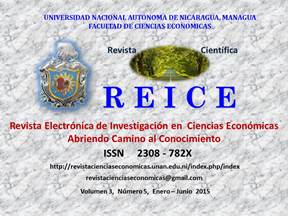J curve estimation in Nicaragua: Econometric Application Almon distributed lag model
DOI:
https://doi.org/10.5377/reice.v3i5.2017Keywords:
Almon distributed lag models, Curve J, devaluation and trade balanceAbstract
This paper aims to empirically demonstrate the J curve and determine the effect of the devaluation of the exchange rate on the balance of trade surplus in Nicaragua. For this purpose, we developed an econometric model, founded on distributed lag models "Almon" for time series. Correspondingly, this assay employs the structure calculation given by Shirley Almon (1965), and follows the proposed ordinary minimum square estimation restricted implemented by Schmidt and Waud (1973), and Giles (1975). The result can confirm the presence of the curve J for the Nicaraguan economy, whose effect lasts approximately two periods, the volume impact is presented in quarters one, two and three post generated devaluation in the exchange rate, ended quarters comprising the volume effect, negative effects arise very significant. Consequently, the proposed model is suitable for estimating the curve J in the Nicaraguan economy and the real exchange rate follows a fourth-degree polynomial distribution and the current political change slide 5 percent annually, has had a positive effect in the balance of trade balance in the long term.
Downloads
1233
Downloads
Published
How to Cite
Issue
Section
License
Copyright (c) Revista Electronica de Investigacion en Ciencias Economicas
The rights to the articles published in REICE are from the journal, in order to be able to manage their best dissemination. However, since the purpose of the same is the dissemination of knowledge, this journal provides immediate free access to its content, under the principle that making research available to the public free of charge, which fosters a greater exchange of global knowledge.
The opinions expressed by the authors do not necessarily reflect the position of the publisher of the publication or of the UNAN-Managua. Its reproduction and distribution is authorized (in any type of support) provided that the following indications are fulfilled:
- The authorship of the work
- Indicate its origin (REICE magazine, volume, number and electronic address of the document)

